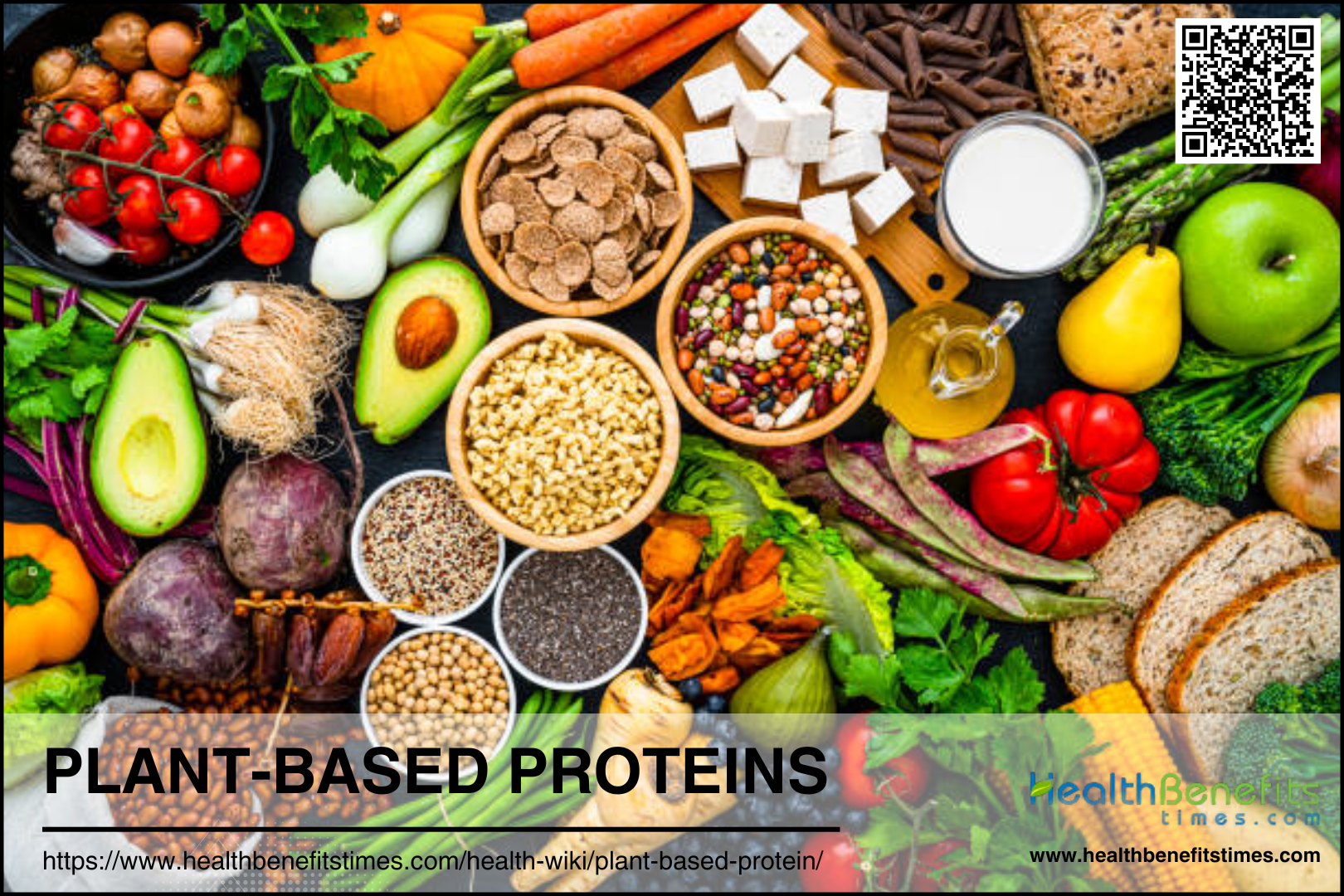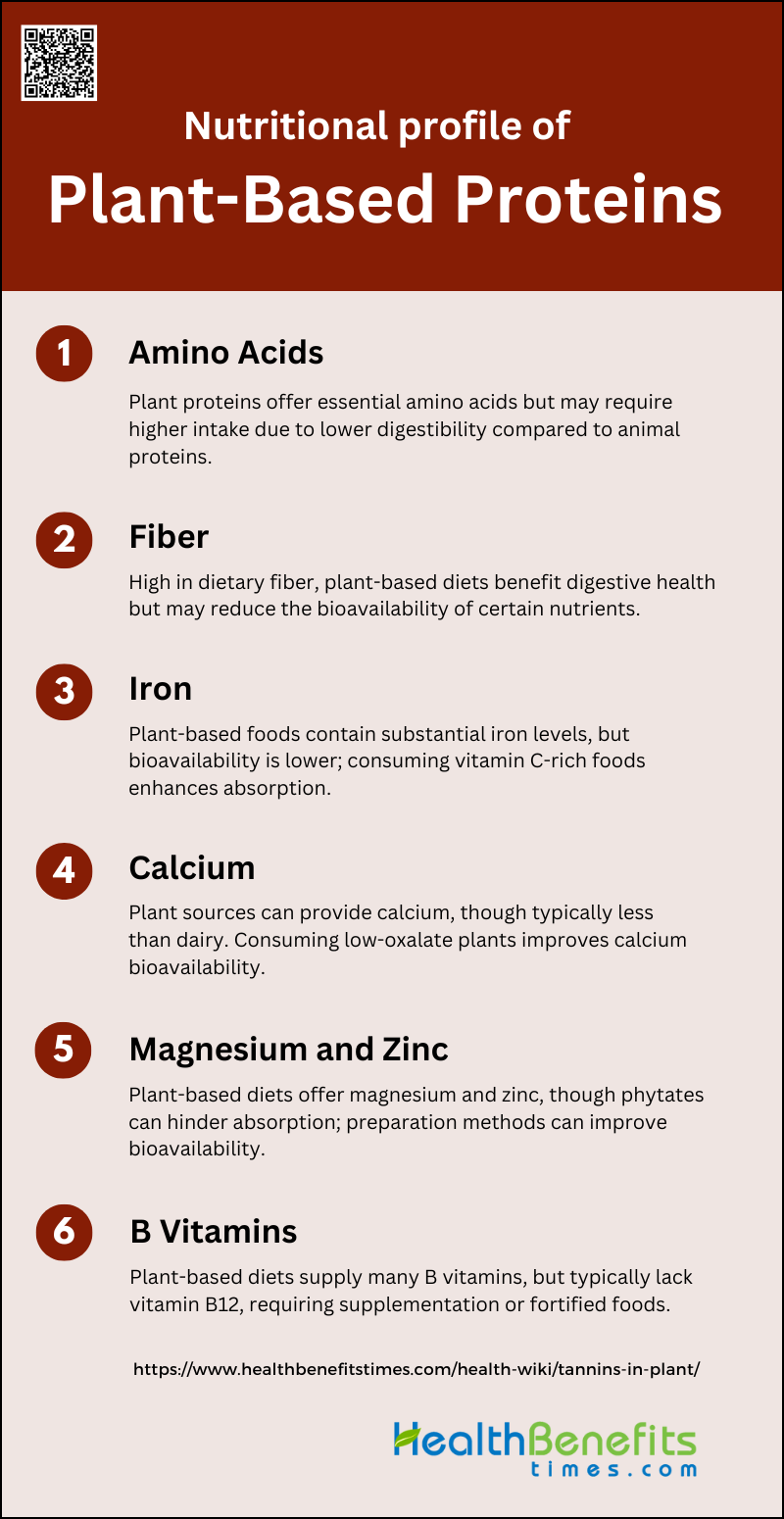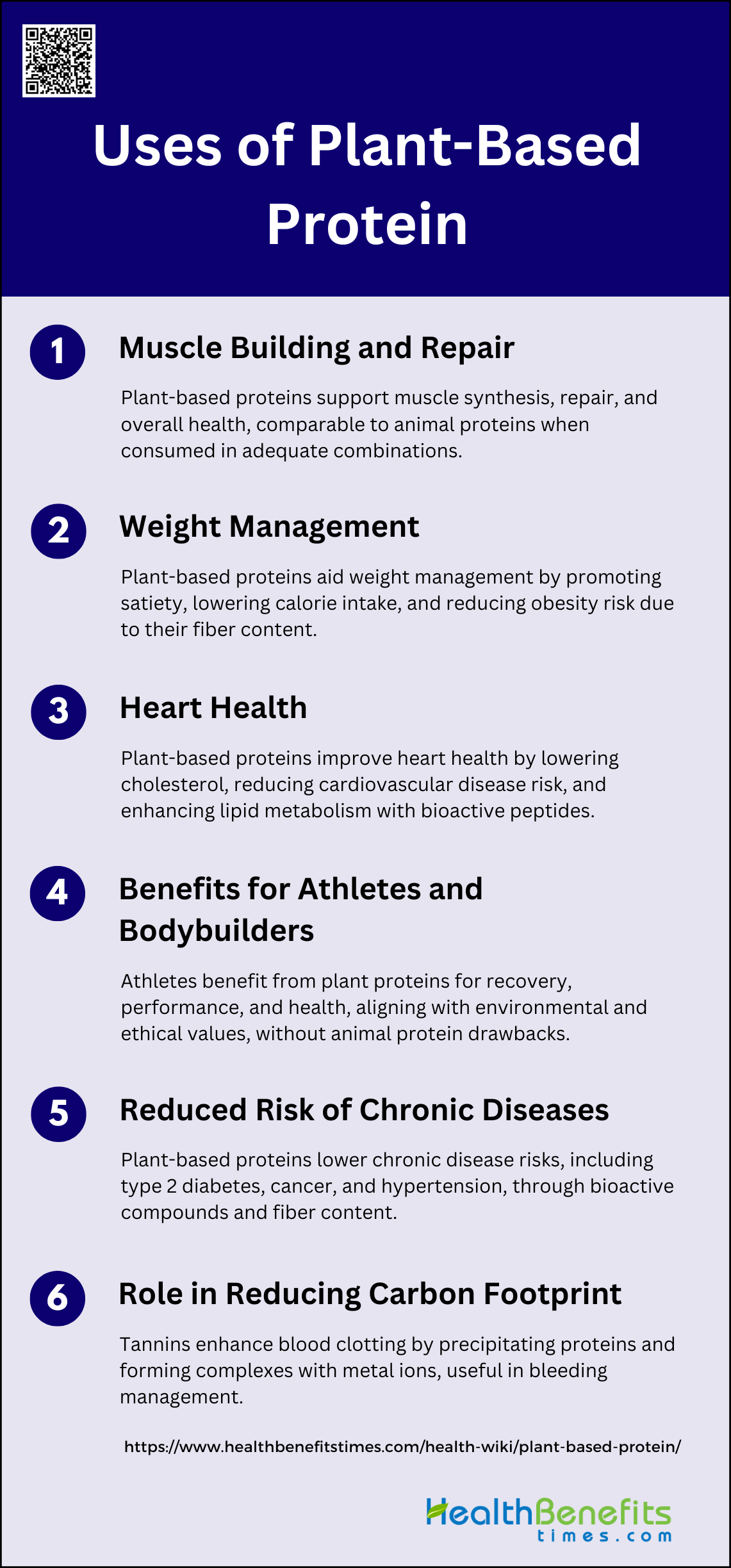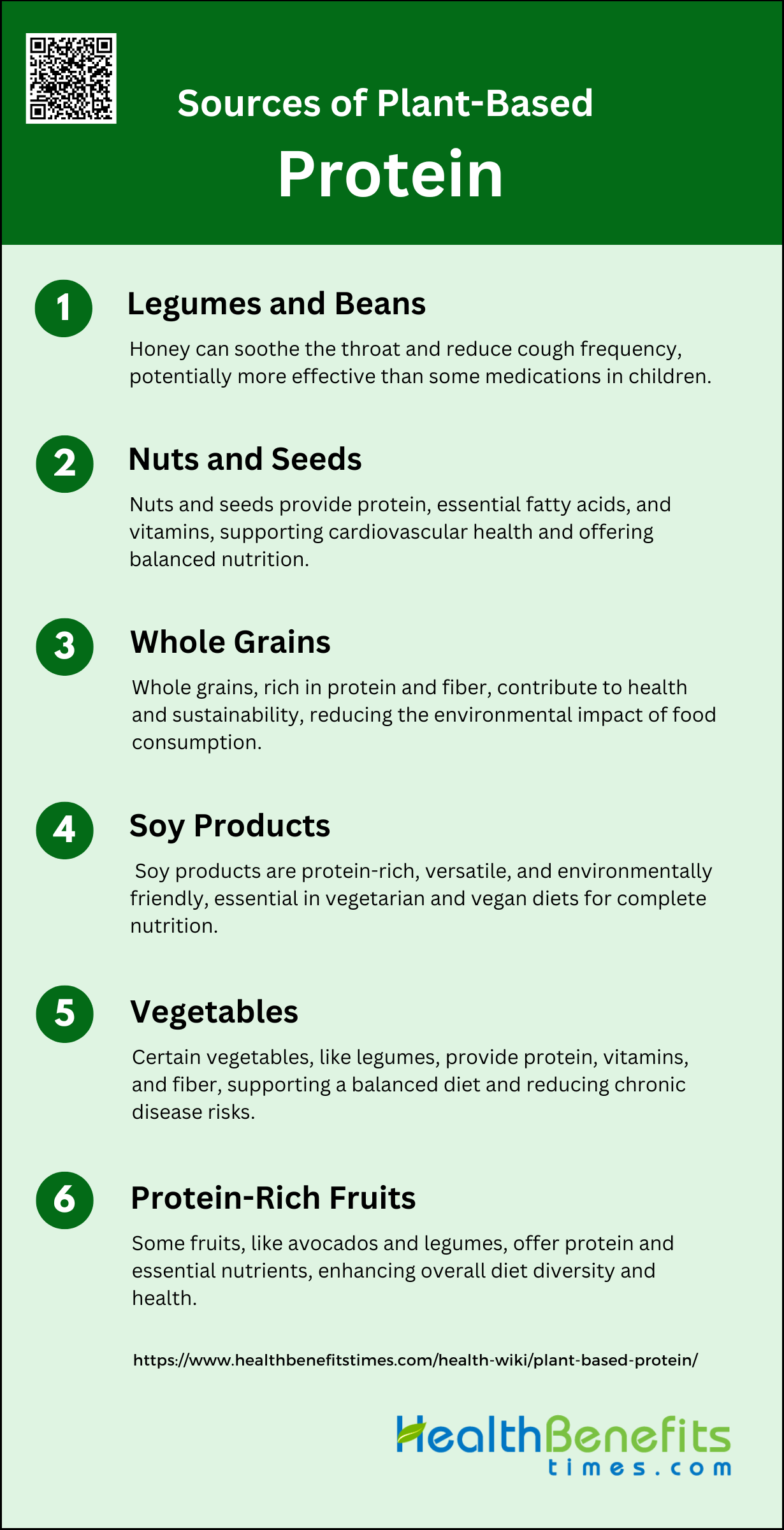Plant-based protein refers to protein derived from plant sources such as legumes, nuts, seeds, grains, and vegetables. This type of protein is gaining popularity as a sustainable and health-conscious alternative to animal-based proteins. Plant-based proteins are often used in products like meat analogues and dairy alternatives, which aim to mimic the texture and taste of traditional animal products while offering nutritional benefits and a smaller environmental footprint. These proteins are rich in essential nutrients and can be beneficial for health, including improved digestion and reduced risk of chronic diseases. However, they may sometimes lack certain essential amino acids found in animal proteins, which can be addressed by consuming a variety of plant-based foods to ensure a complete protein intake. The rising consumer interest in plant-based proteins is driven by concerns about health, sustainability, and ethical considerations related to animal welfare.
Nutritional profile of plant-based proteins
The nutritional profile of plant-based proteins is diverse and beneficial for overall health. These proteins not only provide essential amino acids but also come packed with fiber, vitamins, and minerals. Below is a detailed breakdown of the key nutrients found in plant-based proteins:
1. Amino Acids
Plant-based proteins generally provide a good profile of essential amino acids, though they may sometimes be lower in certain amino acids compared to animal proteins. For instance, Moringa oleifera is rich in essential amino acids such as threonine, valine, methionine, leucine, isoleucine, phenylalanine, histidine, lysine, and arginine, making it a valuable protein source. Similarly, Amaranthus viridis and Hibiscus sabdarifa have amino acid compositions that compare favorably to the World Health Organization (WHO) protein standard. However, the digestibility of plant proteins can be lower, necessitating higher consumption to meet protein needs.
2. Fiber
Plant-based diets are typically high in dietary fiber, which is beneficial for digestive health. For example, edible plants from Mexico, such as Chaya, contain dietary fiber values ranging between 23.1% and 41.8% (dry weight basis), predominantly insoluble fiber. High-protein crops like buckwheat, green pea, and fava bean also contain significant amounts of insoluble fiber, ranging from 9% to 25% (w/w). This high fiber content is advantageous for maintaining gut health and preventing constipation, though it may also affect the bioavailability of certain nutrients.
3. Iron
Iron content in plant-based foods can be substantial, though its bioavailability may be lower compared to animal sources. For instance, high-protein crops such as buckwheat and hemp have iron levels ranging from 20.23 mg/kg to 69.57 mg/kg. Indigenous plants like Ziziphus mauritiana and Adansonia digitata are also rich in iron. However, the absorption of non-heme iron from plants can be inhibited by phytates and other compounds, making it essential to consume iron-rich plants alongside vitamin C-rich foods to enhance absorption.
4. Calcium
Calcium intake from plant-based diets can be lower than from diets that include dairy products. For example, vegans often have lower calcium intake and bone mineral density. However, certain plants are excellent sources of calcium. Moringa oleifera contains 99.1 mg of calcium per serving, and Adansonia digitata leaves are particularly high in calcium. To improve calcium bioavailability, it is recommended to consume low-oxalate and low-phytate vegetables, nuts, seeds, and calcium-rich mineral water.
5. Magnesium and Zinc
Plant-based diets often provide higher magnesium intake compared to meat-based diets. For instance, Moringa oleifera is rich in magnesium (35.1 mg per serving) and zinc (0.85 mg per serving). Indigenous plants like Hibiscus sabdarifa and Ziziphus mauritiana also contain significant amounts of magnesium and zinc. However, the bioavailability of these minerals can be affected by the presence of phytates, which can be mitigated through food preparation techniques such as soaking, germination, and sour-dough leavening.
6. B Vitamins
Plant-based diets can be rich in certain B vitamins but may lack others, such as vitamin B12. Moringa oleifera, for example, is a good source of several B vitamins, including thiamine (B1), riboflavin (B2), niacin (B3), pantothenic acid (B5), vitamin B6, and folic acid (B9). However, vitamin B12 is typically absent in plant foods, necessitating supplementation or consumption of fortified foods for those on strict plant-based diets. Ensuring a varied diet that includes fortified foods can help meet the requirements for these essential vitamins.
Uses of Plant-Based Protein
Plant-based proteins are versatile and can be used in a variety of culinary applications. They serve as excellent meat substitutes, enrich smoothies, and enhance the nutritional value of baked goods. Below are some common uses of plant-based protein:
1. Muscle Building and Repair
Plant-based proteins are increasingly recognized for their role in muscle building and repair. While traditionally animal proteins have been favored for their complete amino acid profiles, plant-based proteins can also support muscle synthesis when consumed in adequate amounts and combinations. Studies indicate that plant-based diets do not disadvantage strength, anaerobic, or aerobic exercise performance compared to omnivorous diets, making them viable for muscle repair and growth. Additionally, plant proteins contribute to overall health by providing essential nutrients and bioactive compounds that support cellular repair and immune function.
2. Weight Management
The consumption of pulses and whole grains, which are rich in plant proteins, has been linked to improved satiety and reduced overall calorie intake, aiding in weight control. Furthermore, plant-based diets are associated with lower body mass index (BMI) and reduced risk of obesity, partly due to their lower fat content and higher nutrient density. These factors make plant-based proteins an effective component of weight management strategies.
3. Heart Health
Plant-based proteins play a significant role in promoting heart health. Diets rich in plant proteins are associated with lower levels of cholesterol and reduced risk of cardiovascular diseases (CVD). The bioactive peptides found in pulses and whole grains can modulate lipid metabolism and reduce oxidative stress, contributing to improved heart health. Additionally, plant-based diets are typically lower in saturated fats and higher in dietary fiber, which are crucial for maintaining healthy blood pressure and reducing the risk of heart disease.
4. Benefits for Athletes and Bodybuilders
Athletes and bodybuilders can benefit from plant-based proteins, which support muscle recovery and performance without the drawbacks of animal proteins. Plant-based diets provide adequate protein for strength, anaerobic, and aerobic exercise performance, making them suitable for athletic endeavors. Moreover, plant proteins are often accompanied by other beneficial nutrients such as vitamins, minerals, and antioxidants, which can enhance overall health and recovery. The environmental and ethical benefits of plant-based diets also align with the values of many athletes.
5. Reduced Risk of Chronic Diseases
Consuming plant-based proteins is linked to a reduced risk of several chronic diseases. Diets high in plant proteins are associated with lower incidences of type 2 diabetes, hypertension, and certain cancers, including colorectal, ovarian, and breast cancers. The bioactive compounds in plant proteins, such as dietary fiber and phenolic compounds, play a role in disease prevention by modulating enzyme activities, improving gut health, and reducing oxidative stress. These health benefits make plant-based proteins a valuable component of a disease-preventive diet.
6. Role in Reducing Carbon Footprint
Plant-based proteins contribute significantly to reducing the carbon footprint of food production. Producing plant-based foods requires fewer natural resources, such as water, land, and energy, compared to animal-based foods. This lower environmental burden makes plant-based diets more sustainable and environmentally friendly. Additionally, reducing the consumption of animal proteins can decrease greenhouse gas emissions from livestock, further mitigating the impact on climate change. Thus, plant-based proteins are not only beneficial for health but also for the planet.
Sources of Plant-Based Protein
Plant-based proteins can be sourced from a wide variety of foods, each offering unique nutritional benefits. These sources are not only rich in protein but also provide essential vitamins and minerals. Below is a list of common sources of plant-based protein:
1. Legumes and Beans
Legumes and beans are vital sources of plant-based protein, especially in developing countries where they are more affordable than meat or cereals. They are rich in essential amino acids and provide significant health benefits. For instance, lentils, a type of legume, are not only high in protein but also contain bioactive peptides that offer additional health benefits. Other legumes like faba beans, peas, and lupins are also valuable protein sources, although their use can be limited by antinutritional factors. Underutilized tropical legumes such as winged bean, lentil, lima bean, lablab, and bambara groundnut are gaining attention for their potential to address global protein shortages and food insecurity.
2. Nuts and Seeds
Nuts and seeds are excellent sources of plant-based protein and are associated with numerous health benefits, including cardiovascular health. Studies have shown that higher intakes of protein from nuts and seeds are linked to lower cardiovascular mortality rates. They are also rich in essential fatty acids, vitamins, and minerals, making them a nutritious addition to any diet. For example, broad beans are particularly high in unsaturated fatty acids, which are beneficial for heart health. The inclusion of nuts and seeds in the diet can provide a balanced source of protein and other essential nutrients.
3. Whole Grains
Whole grains, such as amaranth and buckwheat, are increasingly being recognized for their protein content and environmental benefits. These grains can be combined with other plant-based proteins to create nutritious and sustainable food products. For instance, extrudated vegetable meat alternatives made from these grains have been shown to generate significantly less environmental impact compared to animal-based foods. Whole grains are also rich in dietary fiber and essential minerals, contributing to overall health and well-being. Their integration into plant-based diets can help reduce the environmental footprint of food consumption.
4. Soy Products
Soy products are among the most well-known sources of plant-based protein. They are rich in essential amino acids and have high protein content, making them a staple in many vegetarian and vegan diets. Soybeans, in particular, are noted for their high protein and fat content, as well as their rich lysine levels. They are also used to create various food products, including tofu, tempeh, and soy milk, which are versatile and nutritious. The environmental benefits of soy products are also significant, as they have a lower environmental impact compared to animal-based proteins.
5. Vegetables
While vegetables are not typically known for their high protein content, certain varieties can contribute significantly to daily protein intake. For example, lentils and other legumes are often categorized as vegetables and are excellent sources of protein. Vegetables also provide essential vitamins, minerals, and dietary fiber, making them a crucial component of a balanced diet. The inclusion of protein-rich vegetables in the diet can help meet nutritional needs while also offering various health benefits, such as improved digestion and reduced risk of chronic diseases.
6. Protein-Rich Fruits
Although fruits are generally not high in protein, some varieties can contribute to protein intake. For instance, certain legumes, which are botanically classified as fruits, are rich in protein. These include soybeans and lentils, which are used in various food applications to enhance protein content. Additionally, fruits like avocados and guavas contain higher protein levels compared to other fruits. Including these protein-rich fruits in the diet can provide a diverse range of nutrients, supporting overall health and well-being.
Health benefits of plant-based protein
Plant-based proteins offer numerous health benefits, making them an excellent addition to any diet. They are linked to improved heart health, better digestion, and effective weight management. Below are some key health benefits of incorporating plant-based proteins into your diet:
1. Reduced Risk of Heart Disease
Plant-based proteins have been shown to significantly reduce the risk of heart disease. Diets rich in plant-based foods such as fruits, vegetables, nuts, and whole grains are associated with a lower risk of cardiovascular disease (CVD) due to their beneficial nutrients, including mono- and polyunsaturated fatty acids, omega-3 fatty acids, antioxidant vitamins, minerals, phytochemicals, fiber, and plant protein. These nutrients help in lowering cholesterol levels, reducing blood pressure, and improving overall heart health. Studies indicate that plant-based diets can reduce the risk of coronary heart disease events by up to 40% and cerebral vascular disease events by 29%. Therefore, incorporating plant-based proteins into the diet is a crucial strategy for heart disease prevention and management.
2. Weight Management
Plant-based proteins play a significant role in weight management. Diets high in plant-based foods are often lower in calories and higher in dietary fiber, which promotes satiety and reduces overall calorie intake. Research has shown that substituting animal proteins with plant proteins can lead to a lower body mass index (BMI) and reduced body fat. Additionally, plant-based diets have been associated with improved body composition and weight loss, as evidenced by studies using Dual X-ray Absorptiometry to assess body composition. The high fiber content in plant-based foods also aids in digestion and helps maintain a healthy weight, making plant-based proteins an effective component of weight management strategies.
3. Diabetes Management
Plant-based proteins are beneficial for diabetes management. Studies have shown that plant-based diets can significantly reduce the risk of developing type 2 diabetes by improving insulin sensitivity and glycemic control. For instance, substituting 5% of energy intake from animal protein with plant protein was associated with a 23% lower risk of type 2 diabetes. Plant proteins, such as those from soy, have been found to lower postprandial insulin response compared to animal proteins like whey. These findings suggest that incorporating plant-based proteins into the diet can help manage blood sugar levels and reduce the risk of diabetes-related complications.
4. Cancer Prevention
Plant-based proteins may also play a role in cancer prevention. Diets rich in plant-based foods provide essential nutrients and phytochemicals that have been shown to reduce inflammation and oxidative stress, both of which are linked to cancer development. Some studies have indicated that plant-based diets can lower the risk of certain types of cancer, although more research is needed to fully understand the mechanisms involved. The high fiber content in plant-based foods also aids in maintaining a healthy digestive system, which can further reduce the risk of colorectal cancer. Overall, the consumption of plant-based proteins as part of a balanced diet may contribute to cancer prevention and overall health improvement.
Tips for Incorporating Plant-Based Protein into Your Diet
Incorporating plant-based protein into your diet can be both easy and delicious. By making simple swaps and additions, you can boost your protein intake without relying on animal products. Below are some practical tips for adding more plant-based protein to your meals:
1. Meal Planning
Creating balanced meals with plant-based proteins involves ensuring a variety of nutrient-dense foods to meet all essential amino acid requirements. Combining different plant-based protein sources such as legumes, grains, nuts, and seeds can help achieve a complete amino acid profile. For instance, pairing beans with rice or hummus with whole-grain bread can provide a balanced meal. Additionally, incorporating a variety of vegetables and fruits can enhance the intake of vitamins, minerals, and fiber, which are often higher in plant-based diets compared to meat-based diets.
2. Cooking Techniques
Simple recipes and cooking methods can make plant-based proteins more accessible and enjoyable. Techniques such as soaking and sprouting beans and grains can improve their digestibility and nutrient availability. Stir-frying tofu with vegetables, making lentil soups, or preparing chickpea salads are easy ways to incorporate plant proteins into your diet. Additionally, using spices and herbs can enhance the flavor and nutritional value of plant-based dishes. For example, a stir-fry with tofu, broccoli, and bell peppers seasoned with garlic and ginger can be both nutritious and delicious.
3. Supplements and Protein Powders
Plant-based protein powders can be a convenient way to boost protein intake, especially for those with higher protein needs or limited access to diverse plant foods. Almond protein powder, for example, has been shown to improve nitrogen balance similarly to whey protein, making it a viable alternative. When choosing a supplement, consider factors such as protein content, amino acid profile, and any additional nutrients or additives. It’s also important to use these supplements as part of a balanced diet rather than relying on them as the sole protein source.
FAQs
1. Can plant-based proteins support the nutritional needs of children and adolescents?
Yes, plant-based proteins can support the nutritional needs of children and adolescents. However, it’s important to ensure a well-balanced diet that includes a variety of protein sources to meet their higher energy and nutrient needs. Attention should be paid to providing sufficient calories, essential amino acids, vitamins (such as B12), and minerals (such as calcium and iron).
2. Are there any potential allergens in plant-based proteins?
Yes, some plant-based proteins can be allergens. Common allergens include soy, peanuts, tree nuts, and gluten-containing grains like wheat. Individuals with food allergies should carefully read labels and consult healthcare providers to choose appropriate plant-based protein sources.
3. How does the environmental impact of plant-based protein production compare to animal-based protein production?
Plant-based protein production generally has a lower environmental impact compared to animal-based protein production. It requires less land, water, and energy and results in lower greenhouse gas emissions. This makes plant-based proteins a more sustainable option.
4. How do plant-based protein supplements compare to whole food sources of protein?
Plant-based protein supplements can be a convenient way to increase protein intake, especially for athletes or those with specific dietary needs. However, whole food sources of protein, such as legumes, nuts, and seeds, offer additional nutrients like fiber, vitamins, and minerals that are not always present in supplements.
5. What are the potential digestive issues associated with consuming plant-based proteins?
Some individuals may experience digestive issues, such as bloating or gas, when consuming certain plant-based proteins, particularly those high in fiber like beans and lentils. These issues can often be minimized by proper food preparation methods, such as soaking, sprouting, or gradually increasing fiber intake.
6. Are there any cultural or regional considerations when adopting a plant-based diet?
Yes, cultural and regional dietary practices can influence the adoption of a plant-based diet. In some cultures, plant-based diets are traditional and offer a wide variety of protein sources. In others, dietary habits may be more centered around animal proteins, making the transition to plant-based proteins more challenging. Adapting recipes to include familiar flavors and ingredients can help ease this transition.
7. Can plant-based proteins be used effectively in high-performance sports and bodybuilding?
Yes, plant-based proteins can be used effectively in high-performance sports and bodybuilding. With careful planning to ensure adequate protein intake and a complete amino acid profile, athletes can build muscle, recover from workouts, and perform at a high level on a plant-based diet. Some plant-based protein powders are specifically formulated to support athletic performance.
8. How do plant-based proteins affect gut health compared to animal-based proteins?
Plant-based proteins are often higher in fiber, which can promote a healthy gut microbiome and improve digestion. The increased fiber intake can also aid in preventing constipation. However, some plant proteins may contain antinutritional factors that could affect nutrient absorption, which can be mitigated through proper food preparation techniques.
9. What are the economic implications of switching to plant-based proteins?
Switching to plant-based proteins can have economic implications, both positive and negative. On one hand, plant-based proteins can be more affordable than animal proteins, especially in regions where legumes and grains are staple foods. On the other hand, specialty plant-based products, like meat analogues, can be more expensive than traditional animal products. The cost-effectiveness of a plant-based diet often depends on the types of foods consumed and regional food prices.
10. What are some tips for transitioning to a plant-based diet for someone who is used to eating animal proteins?
Transitioning to a plant-based diet can be easier with gradual changes, such as starting with meatless meals a few times a week or substituting plant-based proteins in familiar recipes. Experimenting with different plant-based protein sources, using spices and herbs to enhance flavors, and learning new cooking techniques can also help make the transition smoother and more enjoyable.





